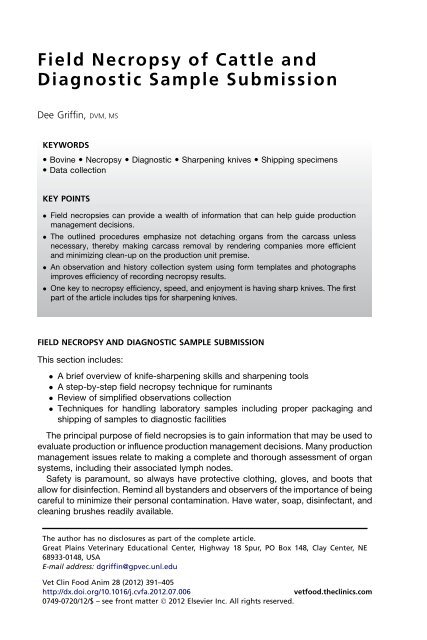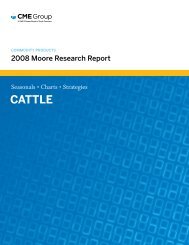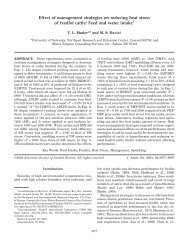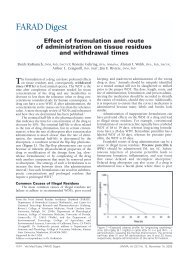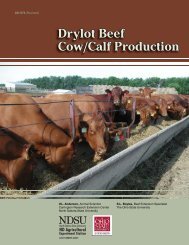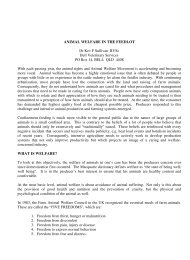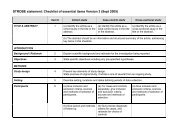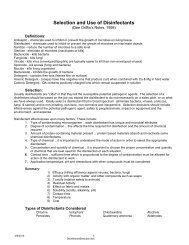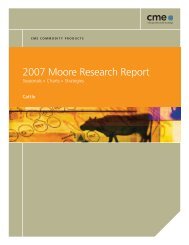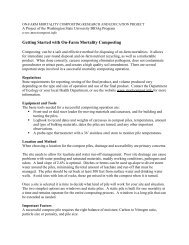Field Necropsy of Cattle and Diagnostic Sample Submission - gpvec
Field Necropsy of Cattle and Diagnostic Sample Submission - gpvec
Field Necropsy of Cattle and Diagnostic Sample Submission - gpvec
You also want an ePaper? Increase the reach of your titles
YUMPU automatically turns print PDFs into web optimized ePapers that Google loves.
<strong>Field</strong> <strong>Necropsy</strong> <strong>of</strong> <strong>Cattle</strong> <strong>and</strong><br />
<strong>Diagnostic</strong> <strong>Sample</strong> <strong>Submission</strong><br />
Dee Griffin, DVM, MS<br />
KEYWORDS<br />
Bovine <strong>Necropsy</strong> <strong>Diagnostic</strong> Sharpening knives Shipping specimens<br />
Data collection<br />
KEY POINTS<br />
<strong>Field</strong> necropsies can provide a wealth <strong>of</strong> information that can help guide production<br />
management decisions.<br />
The outlined procedures emphasize not detaching organs from the carcass unless<br />
necessary, thereby making carcass removal by rendering companies more efficient<br />
<strong>and</strong> minimizing clean-up on the production unit premise.<br />
An observation <strong>and</strong> history collection system using form templates <strong>and</strong> photographs<br />
improves efficiency <strong>of</strong> recording necropsy results.<br />
One key to necropsy efficiency, speed, <strong>and</strong> enjoyment is having sharp knives. The first<br />
part <strong>of</strong> the article includes tips for sharpening knives.<br />
FIELD NECROPSY AND DIAGNOSTIC SAMPLE SUBMISSION<br />
This section includes:<br />
A brief overview <strong>of</strong> knife-sharpening skills <strong>and</strong> sharpening tools<br />
A step-by-step field necropsy technique for ruminants<br />
Review <strong>of</strong> simplified observations collection<br />
Techniques for h<strong>and</strong>ling laboratory samples including proper packaging <strong>and</strong><br />
shipping <strong>of</strong> samples to diagnostic facilities<br />
The principal purpose <strong>of</strong> field necropsies is to gain information that may be used to<br />
evaluate production or influence production management decisions. Many production<br />
management issues relate to making a complete <strong>and</strong> thorough assessment <strong>of</strong> organ<br />
systems, including their associated lymph nodes.<br />
Safety is paramount, so always have protective clothing, gloves, <strong>and</strong> boots that<br />
allow for disinfection. Remind all byst<strong>and</strong>ers <strong>and</strong> observers <strong>of</strong> the importance <strong>of</strong> being<br />
careful to minimize their personal contamination. Have water, soap, disinfectant, <strong>and</strong><br />
cleaning brushes readily available.<br />
The author has no disclosures as part <strong>of</strong> the complete article.<br />
Great Plains Veterinary Educational Center, Highway 18 Spur, PO Box 148, Clay Center, NE<br />
68933-0148, USA<br />
E-mail address: dgriffin@<strong>gpvec</strong>.unl.edu<br />
Vet Clin Food Anim 28 (2012) 391–405<br />
http://dx.doi.org/10.1016/j.cvfa.2012.07.006 vetfood.theclinics.com<br />
0749-0720/12/$ – see front matter Ó 2012 Elsevier Inc. All rights reserved.
392<br />
Griffin<br />
KNIFE-SHARPENING SKILLS<br />
A quick alternative to using a knife-sharpening abrasive is to use a “V” carbide blade<br />
knife sharpener. These put a very coarse, crudely shaped, yet usable edge on a knife<br />
blade.<br />
Sharpening Abrasives<br />
Although 3-sided oil stones work well, these are generally expensive <strong>and</strong> do not travel<br />
well when needed for field necropsies. Solid abrasives such as diamond-coated steel<br />
slabs are more durable than stone abrasives. They are easily cleaned <strong>and</strong> come in an<br />
assortment <strong>of</strong> grits. Most knives can be sharpened nicely with any abrasive that is finer<br />
than 300 grit (medium or fine).<br />
Angle consistency, or the angle at which the blade is held as the abrasive is stroked,<br />
is by far the most important key to developing a sharp cutting edge. There are several<br />
diamond-coated sharpening abrasives designed to maintain a consistent sharpening<br />
angle. Most feature a clamp to hold the knife blade, <strong>and</strong> the abrasive is connected to<br />
a rod that slides through angle slots above <strong>and</strong> below the knife’s cutting edge.<br />
A consistent edge can be maintained on a flat abrasive if the back <strong>of</strong> the knife blade<br />
is pushed into the palm side <strong>of</strong> the thumb <strong>and</strong> the side <strong>of</strong> the thumb is laid flat against<br />
the abrasive as it is stroked (Fig. 1). It is difficult to maintain a consistent angle when<br />
using a diamond-coated sharpening rod or steel, <strong>and</strong> for this reason, these sharpening<br />
tools are not recommended.<br />
The best knife-sharpening abrasives for veterinary practitioners are motorized. The<br />
author strongly encourages having a high-quality diamond-coated, set-angle disk<br />
sharpener in clinics. The better diamond hone machines have 3 sharpening stages,<br />
meaning that there are 3 slightly different angles for the abrasives. The final stage in<br />
these usually is 5 wider, which provides increased durability to the cutting edge. Diamond<br />
honing knife sharpeners can be found at most large department stores in the<br />
kitchen appliance area. Buy lots <strong>of</strong> knives <strong>and</strong> keep several sharp knives in the practice<br />
vehicle. Purchase a good-quality motorized knife sharpener <strong>and</strong> delegate the<br />
sharping to a technician.<br />
Angles <strong>of</strong> a Sharp Cutting Edge<br />
There is no perfect angle for a cutting edge . but, instead, knives with a cutting edge<br />
angle not suitable for the intended job. The steeper the angle, the thinner is the blade<br />
near the cutting edge <strong>and</strong> the less durable is the cutting edge. Although durability is<br />
lost with steeper angles, the resistance caused by the knife sliding through the tissue<br />
is less. Examples include slicing knifes. Similarly, the flatter the sharpening angle, the<br />
thicker is the steel to support the cutting edge <strong>and</strong> therefore the more durable. The<br />
kind <strong>of</strong> angle targeted for axes <strong>and</strong> shears is shown (Fig. 2). A flat file works well for<br />
Fig. 1. A consistent angle can be maintained while developing a cutting edge by holding<br />
the back <strong>of</strong> the knife blade against the thumb <strong>and</strong> resting the thumb on the flat sharpening<br />
abrasive.
<strong>Field</strong> <strong>Necropsy</strong> <strong>and</strong> <strong>Sample</strong> <strong>Submission</strong> 393<br />
Fig. 2. The angle <strong>of</strong> the knife’s cutting edge determines its durability <strong>and</strong> the ease with<br />
which a sharp cutting edge slides through tissues. Select the edge best suited for the job.<br />
sharpening the s<strong>of</strong>t metal found in axes <strong>and</strong> shears. <strong>Necropsy</strong> knives seem to work<br />
well if the angle is 15 to 25 . Again, the key is keeping the angle constant when developing<br />
a cutting edge.<br />
Finishing the Cutting Edge<br />
A ceramic sharpening rod is one <strong>of</strong> the betters tools for honing a fine edge on a properly<br />
sharpened knife blade. When using a ceramic rod or metal steel, stroke the blade<br />
gently, feeling for defects in the cutting edge as the blade slides down the tool.<br />
Determining When the Edge is Sharp<br />
A sharp cutting edge should be as smooth as glass. The best <strong>and</strong> safest way to test<br />
the edge is to hold a plastic ink pen at a 45 angle <strong>and</strong> see if the knife blade will sit on<br />
the pen without sliding down the pen barrel. If it holds onto the plastic barrel, the<br />
cutting edge is sharp. Additionally, no defects should be felt when the plastic barrel<br />
<strong>of</strong> the ink pen is lightly slid down the cutting edge (Fig. 3).<br />
The Keys to Having Sharp <strong>Necropsy</strong> Knives<br />
Do not use the necropsy knife for jobs that will damage its cutting edge. For example,<br />
use a disposable bladed box cutter for skin incisions, thereby not damaging the<br />
cutting edge <strong>of</strong> the necropsy knife on hide, hair, <strong>and</strong> dirt. Do not use a necropsy knife<br />
for cutting rib cartilage unless it is <strong>of</strong> a very young animal. A shear or axe works well<br />
Fig. 3. Testing the sharpness <strong>of</strong> a cutting edge is easily done using a plastic ink pen or the<br />
thumbnail. Sharp cutting edges will grab the barrel or the thumbnail when held at a 45<br />
angle <strong>and</strong> not slip down. Additionally, a sharp cutting edge will feel smooth as a plastic<br />
pen or thumbnail is slid down the edge.
394<br />
Griffin<br />
<strong>and</strong> saves the cutting edge <strong>of</strong> the knife. Use a ceramic rod to repeatedly touch up the<br />
cutting edge during the necropsy.<br />
FIELD NECROPSY PROCEDURE WITH MINIMAL LOOSE PARTS<br />
Important Note<br />
Animals that will be rendered must not contain chemical residues that could be harmful<br />
to other animals that would consume rendered products. 1<br />
Start with the Ruminant on its Left Side<br />
Think about what is observed. Collect histopathologic <strong>and</strong> culture specimens while<br />
working. Histopathologic specimens should not be thicker than 5 to 7 mm. Try to<br />
connect observations into a unifying diagnosis or production management<br />
observation.<br />
The procedure outlined is designed to make it easier for animals to be picked up by<br />
rendering trucks <strong>and</strong> to minimize hide damage, thereby improving the hide value to<br />
renderers. Detaching any organs that are not required for examination is not being<br />
considerate <strong>of</strong> the people working for the rendering company <strong>and</strong> is more likely to<br />
create a mess at the farm, ranch, or feedlot on which the necropsy examination is<br />
being performed.<br />
Review Anatomy <strong>and</strong> Gross Pathology<br />
Knowledge <strong>of</strong> the structure <strong>and</strong> function <strong>of</strong> the organ tissues being examined can be<br />
key to linking observations to a meaningful diagnosis. 2,3 Be slow to jump to diagnostic<br />
conclusion based on the first observations. The “lift a leg <strong>and</strong> look” or “peek-a-boo”<br />
necropsies generally leave important production management observation undiscovered<br />
<strong>and</strong> minimize the value <strong>of</strong> the observations that could have contributed to better<br />
animal care <strong>and</strong> management.<br />
Accessing the Brain<br />
It is important to check with the rendering company serving the animal facility about the<br />
acceptability <strong>of</strong> examining the brain, because some companies will not pick up carcasses<br />
that have had the cranium opened. Also remember that rabies should be on the differential<br />
list for all central nervous system cases, so take all appropriate precautions.<br />
Fig. 4 demonstrates the appropriate lines for removal <strong>of</strong> the calvaria. The cut needs<br />
to be approximately as deep as the distance from the front <strong>of</strong> the skull to the lateral<br />
Fig. 4. The steps for opening the skull with an axe to expose the brain. (A) Cut across the<br />
face just dorsal to the lateral canthus then cut from the lateral canthus dorsal in front <strong>of</strong><br />
the ear over to the poll, across the poll to the level <strong>of</strong> the opposite ear. (B) Using the blunt<br />
side <strong>of</strong> the single-bit axe, strike the edge <strong>of</strong> the cut bone between the lateral canthus <strong>and</strong><br />
the ear at a 45 angle. (C) This will break the skull away from the brain.
<strong>Field</strong> <strong>Necropsy</strong> <strong>and</strong> <strong>Sample</strong> <strong>Submission</strong> 395<br />
canthus. Make sure the axe cuts are completely through the cranium. Using the blunt<br />
or hammer side <strong>of</strong> the single-bit axe, strike the cut edge <strong>of</strong> the cranium along the<br />
frontal crest at a 45 angle (see Fig. 4).<br />
To remove the brain, cut the dura mater across the cerebral falx, the tough medial<br />
division <strong>of</strong> the dura. Extend this cut to allow the fingers to slide beneath the cerebrum.<br />
Using the necropsy knife, cut between the cerebrum <strong>and</strong> the cerebellum at the level <strong>of</strong><br />
the pons <strong>and</strong> lift the cerebrum out <strong>of</strong> the cranium. Next, split the dura mater covering<br />
the cerebellum dorsally. Slide the tip <strong>of</strong> the necropsy knife behind the cerebellum into<br />
the spinal canal <strong>and</strong> cut across the spinal cord distal to the obex. Lift out the cerebellum<br />
<strong>and</strong> spinal cord, containing the obex.<br />
Opening the Hide <strong>and</strong> Reflecting the Legs<br />
Using a box cutter, cut along the underside <strong>of</strong> the jaw, over the larynx, <strong>and</strong> down the<br />
neck over the trachea. The incision should drift toward the animal’s right foreleg axillary<br />
space. Continue the skin incision along the ventral thorax, crossing the costal<br />
cartilages <strong>and</strong> along the abdominal wall toward the right rear inguinal area. The incision<br />
across the thorax <strong>and</strong> abdomen will be lateral to the midline 3 to 6 inches (Fig. 5).<br />
Do not cut the hide upward toward the scapula as the foreleg axillary space is<br />
passed. The hide is worth half <strong>of</strong> the value <strong>of</strong> the carcass to the renderer, <strong>and</strong> mutilating<br />
the hide reduces its value so much that many renderers will not pick up necropsied<br />
carcasses without charging a fee if the hide is damaged.<br />
Reflect the rear leg before attempting to reflect the foreleg. To reflect the rear leg,<br />
cut the heavy muscles (adductor, semimembranosus, pectineus, <strong>and</strong> sartorius) that<br />
hold the cox<strong>of</strong>emoral joint in place. The round ligament will be easily identified <strong>and</strong><br />
the joint examined (see Fig. 5).<br />
The best approach to examining the stifle <strong>and</strong> hock joints is to start with the rear leg<br />
reflected <strong>and</strong> then skin along the inside <strong>of</strong> the leg from the stifle joint past the hock<br />
joint. To examine the stifle joint, cut along the side <strong>of</strong> the femoral trochlea <strong>and</strong> cut<br />
above the patella through its attachment to the quadriceps down to the femur. The<br />
patella will rotate over, yielding a great view to the stifle joint. To examine the hock<br />
joint, slide the necropsy knife between the extensor muscles <strong>and</strong> the tibia <strong>and</strong> cut<br />
the extensors loose below the stifle joint. Retracting the extensor muscles will allow<br />
the knife to be slide down to the hock joint, <strong>and</strong> then pull up the joint capsule, thus<br />
allowing one to cut open the joint capsule without invading the joint with the tip <strong>of</strong><br />
the knife blade. This allows for cleaner joint sampling.<br />
Fig. 5. Note the real leg is reflected while the foreleg remains unreflected. Working from<br />
the back side, continue to skin forward toward the foreleg. Lift the foreleg <strong>and</strong> cut through<br />
the latissimus dorsi holding the foreleg down.
396<br />
Griffin<br />
Working from the back side, continue to skin the carcass toward the fore leg. When<br />
skinned to the level <strong>of</strong> the transverse processes <strong>and</strong> proximal rib attachments, the latissimus<br />
dorsi holding the foreleg down will be easily cut. Move to the sternal side <strong>of</strong> the<br />
animal <strong>and</strong> lift the foreleg, cutting the pectoral muscles. The foreleg should lay over<br />
with only minor fascia dissection.<br />
Examining the Oral Cavity <strong>and</strong> Neck Structures<br />
Incise along the side <strong>of</strong> the cheek, exposing the premolars <strong>and</strong> molars. This approach<br />
provides a good view <strong>of</strong> the oral cavity <strong>and</strong> allows for examination <strong>of</strong> molar eruption<br />
(Fig. 6). The first molar erupts in cattle at approximately 7 months <strong>of</strong> age <strong>and</strong> is in<br />
full wear at approximately 12 months. 4 This information can be useful when examining<br />
stocker <strong>and</strong> light feeder cattle.<br />
To examine the tongue <strong>and</strong> larynx, slide the knife on the caudal side <strong>of</strong> the hyoid<br />
bones, feeling for the bend formed between the epihyoid <strong>and</strong> the ceratohyoid bones.<br />
The knife will generally cut the cartilage connection easily in younger animals. Shears<br />
can be used if needed.<br />
Reflect the tongue while dissecting the larynx, trachea, <strong>and</strong> esophagus. Open the<br />
esophagus, larynx, <strong>and</strong> trachea down to the level <strong>of</strong> the thoracic inlet for examination.<br />
If a “bloat-line” observation is potentially important in the necropsy, this would be<br />
a good time to separate the esophagus from the trachea to the level <strong>of</strong> the thoracic<br />
inlet. Later in the necropsy, when the pluck is reflected over the first rib, the esophagus<br />
can be retracted through the thoracic inlet <strong>and</strong> its entire length can be examined.<br />
Opening the Abdomen <strong>and</strong> Thorax<br />
There are several acceptable ways to gain entry into the abdomen. The author generally<br />
starts by incising the abdominal wall along the greater curvature <strong>of</strong> the last rib,<br />
being careful not to incise the intestine. Once a h<strong>and</strong>-size hole is made, the author<br />
reverses the grip on the necropsy knife so the tip <strong>of</strong> the h<strong>and</strong>le is forward, slides<br />
the h<strong>and</strong> into the abdomen with the knife h<strong>and</strong>le leading the cutting edge, <strong>and</strong> incises<br />
the abdominal wall as the h<strong>and</strong> is advanced (Fig. 7). The incision is continued until the<br />
abdominal wall can be reflected.<br />
The greater omentum is cut away, revealing the small intestine <strong>and</strong> allowing the<br />
abdominal viscera to shift away from the diaphragm, which is examined <strong>and</strong> cut free<br />
along its costal attachment. Using shears or an axe, cut across the distal ribs close to<br />
Fig. 6. The cheek has been incised, exposing the molars <strong>and</strong> oral cavity for examination.
Fig. 7. Opening the abdomen by working with the h<strong>and</strong> inside <strong>and</strong> the knife blade pointing<br />
outside will help prevent puncturing loops <strong>of</strong> intestine.<br />
the costochondral junctions. The ribs may be separated <strong>and</strong> manually reflected by<br />
breaking the costovertebral joint, or one can cut across the proximal ribs close to the<br />
costovertebral joints <strong>and</strong> reflect the entire plate <strong>of</strong> ribs forward <strong>of</strong>f the top <strong>of</strong> the thoracic<br />
organs (Figs. 8 <strong>and</strong> 9). Leave the first rib intact. This will hold the thoracic organs in the<br />
carcass as it is winched onto the rendering truck. It is always a good idea to be considerate<br />
<strong>of</strong> both production personnel <strong>and</strong> those who work for the renderer.<br />
Examining the Thoracic Cavity<br />
First examine the pericardial sac <strong>and</strong> fluid. Detach the lung by cutting between the<br />
thoracic vertebra <strong>and</strong> aorta. Then dissect the dorsal lung free from the anterior<br />
thoracic to the diaphragm (Fig. 10). Next, free the caudal right lung lobe from the diaphragm<br />
by cutting the aorta, esophagus, <strong>and</strong> mediastinal reflections (right <strong>and</strong> left)<br />
between the pericardial sac <strong>and</strong> diaphragm. Continue detaching the pluck by cutting<br />
attachments between the pericardial sac <strong>and</strong> ventral thoracic. Reflect the lungs <strong>and</strong><br />
heart forward over the first rib (Fig. 11).<br />
Palpate the lung for abnormalities. Examine the tracheobronchial lymph nodes <strong>and</strong><br />
airways. Examine the thoracic esophagus. The esophagus can be pulled through the<br />
thoracic inlet if a potential bloat line is <strong>of</strong> interest.<br />
The heart’s pericardium, myocardium, <strong>and</strong> endocardium are evaluated as the organ<br />
is opened. Start the examination with the right heart. Make an incision in the right<br />
ventricle just below the vena cava <strong>and</strong> extend the incision through the semilunar<br />
Fig. 8. Cut across the ribs close to the costovertebral junctions.<br />
<strong>Field</strong> <strong>Necropsy</strong> <strong>and</strong> <strong>Sample</strong> <strong>Submission</strong> 397
398<br />
Griffin<br />
Fig. 9. After cutting across the ribs dorsally <strong>and</strong> the ventral costochondral junctions, reflect<br />
the rib plate forward.<br />
valves. Extend the incision distally along the border <strong>of</strong> the right ventricular wall around<br />
its entire connection to the septal wall. This flaps the right ventricle <strong>and</strong> allows an<br />
excellent view <strong>of</strong> the tricuspid valve. To open the left ventricle, make an incision in<br />
the middle <strong>of</strong> the ventricle such that when opened, the 2 large papillary muscles will<br />
lay on either side <strong>of</strong> the incision. Cut across the ventricle just below the coronary<br />
grove. This forms a “T”-shaped incision, allowing the bicuspid valves to be examined.<br />
The left semilunar valves can be examined by extending the vertical incision into the<br />
aorta. These steps are illustrated from left to right in Fig. 12.<br />
Examining the Abdominal Cavity<br />
The small intestines can be fanned out or spread over the rumen for examination<br />
(Fig. 13). Autolysis generally makes opening the entire length <strong>of</strong> the intestine pointless.<br />
Fig. 10. To remove the lung <strong>and</strong> heart, start by dissecting the lung away from the thoracic<br />
vertebra. Continue dissecting the lung free from the diaphragm <strong>and</strong> the pericardial attachments<br />
from the sternum.
However, mesenteric lymph nodes will retain their architecture longer than bowel <strong>and</strong><br />
are useful in evaluating inflammatory changes. Always examine the ileocecal valve for<br />
signs <strong>of</strong> inflammation as could be associated with salmonellosis.<br />
Although the small intestine is spread over the rumen, examine the right kidney <strong>and</strong><br />
liver. Flip the small intestine over the transverse processes, exposing the small colon<br />
(Fig. 14), left kidney, bladder, distal colon, <strong>and</strong> rectum (if a female, their reproductive<br />
organs) for examination.<br />
Make a palm-size hole in the rumen behind the anterior pillars. Reach in <strong>and</strong> find the<br />
ruminoreticular fold. Pull the fold to surface <strong>and</strong> examine the side next to the cranial<br />
sack for acidosis lesions or scars.<br />
Palpate the abomasum, reticulum, <strong>and</strong> omasum for masses <strong>and</strong> normal texture.<br />
Reach under the anteroventral edge <strong>of</strong> the abomasum next to the diaphragm <strong>and</strong><br />
grasp the spleen. Retract the spleen for examination. Open the abomasum to examine<br />
the surface for lesions such as ulcers, parasites, or scarring.<br />
RECORDING OBSERVATIONS<br />
<strong>Field</strong> <strong>Necropsy</strong> <strong>and</strong> <strong>Sample</strong> <strong>Submission</strong> 399<br />
Fig. 11. Reflect the lung over the first rib. It allows for complete examination <strong>of</strong> the lung,<br />
associated lymph nodes, <strong>and</strong> heart.<br />
The principal purpose <strong>of</strong> field necropsies is to gain information that may evaluate or<br />
influence production management decisions. <strong>Necropsy</strong> reports are intended to<br />
communicate the necropsy observations to others <strong>and</strong> to serve as a record that<br />
Fig. 12. The sequence represents the recommended steps for examining the heart. This<br />
approach allows for thorough examination <strong>of</strong> all valves <strong>and</strong> myocardial muscle structure.<br />
(A) The knife opens the right ventricle, allowing the incision (B) to extend into the outflow.<br />
(C) The right ventricle has been completely opened, allowing examination <strong>of</strong> the tricuspid<br />
valve. (D) Two incisions have been made in the left ventricle. One has been longitudinally<br />
<strong>and</strong> the other across the ventricle below the coronary grove. This exposes the bicuspid valve<br />
for examination. (E) The longitudinal incision has been extended through the aorta.
400<br />
Griffin<br />
Fig. 13. Fan the small intestine over the rumen for examination <strong>and</strong> cut across the mesenteric<br />
lymph nodes.<br />
can be used in production management. The brevity that many practice in our reports<br />
creates severe deficiencies in communication. There is a better way.<br />
<strong>Necropsy</strong> Observations Check-Off Form<br />
A form can be created that allows rapid highlighting <strong>of</strong> the circumstance <strong>and</strong> health<br />
management history, noting <strong>and</strong> checking <strong>of</strong>f body systems involved, highlighting<br />
observations within each system examined, <strong>and</strong> summarizing tentative causes or<br />
diagnosis (Fig. 15). This is particularly beneficial when necropsies are performed by<br />
trained personnel instead <strong>of</strong> the veterinarian. A consistent set <strong>of</strong> digital photographs<br />
<strong>of</strong> each necropsy that includes the animal’s identification tag in each photograph<br />
can be valuable when communicating with the <strong>of</strong>f-site veterinarian, pathologist, or<br />
lawyer. The photograph taken may include the surface <strong>and</strong> opened view <strong>of</strong> the lung<br />
with the tracheobronchial lymph node, heart, kidney, <strong>and</strong> the small intestine with an<br />
associated mesenteric lymph node. A necropsy form for cattle can be divided into 3<br />
parts: history, observations, <strong>and</strong> cause or diagnosis.<br />
The history portion <strong>of</strong> the form should include the date, animal identification <strong>and</strong><br />
description, environmental stress information, <strong>and</strong> health information. It may or may<br />
not include a vaccination history, but this could easily be added.<br />
The observation portion <strong>of</strong> the form includes each body system <strong>and</strong> several observations<br />
that can be made in each body system. Users will likely be uncomfortable<br />
trying to limit their observations to the number available on a form. The quality <strong>and</strong><br />
Fig. 14. Flip the small intestine over the transverse processes to expose the small colon <strong>and</strong><br />
allow access to the distal colon, left kidney, bladder, <strong>and</strong> reproductive system.
Fig. 15. Example <strong>of</strong> a “check-<strong>of</strong>f” necropsy observation collection form.<br />
quantity <strong>of</strong> information gathered will far exceed what is typically found in most practitioners<br />
brief necropsy reports.<br />
The cause <strong>and</strong> diagnostic section <strong>of</strong> the form may include a series <strong>of</strong> boxes that<br />
allows one to numerically rank the observer’s opinion <strong>of</strong> the importance <strong>of</strong> the body<br />
system involved <strong>and</strong> rank the suspected cause involved. The final portion <strong>of</strong> the<br />
form has a place for comments <strong>and</strong> suspected diagnosis.<br />
The highlights <strong>of</strong> each necropsy can be kept in a simple Micros<strong>of</strong>t Excel spreadsheet<br />
or Micros<strong>of</strong>t Access (Redmond, WA, USA) database. This allows necropsy<br />
report forms to be easily searched for relationships between cases <strong>and</strong> production<br />
management decisions.<br />
The form described in a Micros<strong>of</strong>t Word format can be downloaded from the University<br />
<strong>of</strong> Nebraska – Lincoln, Great Plains Veterinary Educational Center’s Internet site<br />
(http://GPVEC.UNL.EDU) under “Griffin’s Teaching Files.” 5<br />
HANDLING, PACKAGING, AND SHIPPING DIAGNOSTIC SPECIMENS<br />
<strong>Field</strong> <strong>Necropsy</strong> <strong>and</strong> <strong>Sample</strong> <strong>Submission</strong> 401<br />
Tissue specimen degradation is a serious issue that can severely h<strong>and</strong>icap a diagnostic<br />
laboratory’s ability to provide usable information. Histopathology specimens<br />
should be sliced thin, less than 7 mm, at the time they are collected. Intestine tissue<br />
samples are especially sensitive to crushing damage, <strong>and</strong> it is important to ensure<br />
the 10% formalin (3.7% formaldehyde) is in contact with the intestinal lining. If formalin<br />
is not available at the time <strong>of</strong> necropsy, keep the samples cold <strong>and</strong> separated. Most<br />
pathologists suggest taking samples from all major body systems with associated<br />
lymph nodes if changes are noted. More than 1 sample would be appropriate from<br />
the body system(s) that exhibited significant pathologic changes, including sections<br />
along the boundaries between normal <strong>and</strong> abnormal tissue.<br />
Tissue samples collected for microbiology pose unique challenges. These specimens<br />
generally are not sliced as thin as are specimens for histopathologic examination<br />
<strong>and</strong> therefore are more prone to heat degradation. The bacteria in the<br />
specimen, targeted for both culture <strong>and</strong> contaminants, continue to grow. Contaminant<br />
bacteria may replicate faster <strong>and</strong>/or they may produce substances as they grow that<br />
inhibit the replication <strong>and</strong> subsequent recovery <strong>of</strong> the targeted bacterium. For this<br />
reason, the author frequently collects a needle aspirate <strong>of</strong> the tissue to culture <strong>and</strong><br />
collects tissue specimens for laboratory microbiologist.<br />
Needle aspirate collection for microbiology is a simple procedure that allows<br />
submission <strong>of</strong> an inoculated blood agar plate to the laboratory along with the other<br />
specimens. Starting cultures in the field improves the turnaround time <strong>and</strong> can<br />
improve the accuracy <strong>of</strong> diagnosis <strong>of</strong> some diseases. The author takes aspirates using<br />
a 10-mL syringe <strong>and</strong> a 20-gauge 1.5-inch needle. The author flames the needle using
402<br />
Griffin<br />
a butane lighter until it is red hot, then inserts it into the target tissue to be cultured. The<br />
hot needle should sear the surface <strong>and</strong> prevent contamination <strong>of</strong> the aspirate from<br />
surface contaminants. Aspirate fluid <strong>and</strong> tissue into the needle <strong>and</strong> syringe. After<br />
necropsy, the author sprays collected aspirates on blood agar plates. Next, bend<br />
the 1.5-inch needle in a 45 angle <strong>and</strong> flame the angle formed until sterile. Use the<br />
bent needle to streak the agar plate (Fig. 16). Tape the edges <strong>of</strong> the agar plates.<br />
Double bag each plate, <strong>and</strong> it is ready for shipping to diagnostic laboratory.<br />
Fig. 16. Starting bacteriology culture shortly after the necropsy provides an additional<br />
opportunity for the diagnostic laboratory to make a better evaluation. In this illustration,<br />
a needle aspirate has been inoculated on a blood agar plate <strong>and</strong> the aspirating needle, after<br />
bending <strong>and</strong> heat sterilization, is used to streak the agar inoculum.
<strong>Field</strong> <strong>Necropsy</strong> <strong>and</strong> <strong>Sample</strong> <strong>Submission</strong> 403<br />
Important packaging <strong>and</strong> shipping definitions6–8 Biologic substances, category B means any human or animal material being<br />
shipped for diagnostic purposes. These specimens must have both a “Biologic<br />
Substance” label <strong>and</strong> a UN3373 diamond logo (Fig. 17) on the shipping container.<br />
As noted, the “Infectious Substances” designation does not apply to diagnostic<br />
specimens that would be shipped to diagnostic laboratories. Appropriate labels<br />
are available online or from a state diagnostic laboratory.<br />
The 10% formalin used for animal diagnostic samples is a volume-per-volume<br />
mixture <strong>of</strong> 1 part 37% formaldehyde added to 9 parts water (with or without additional<br />
buffers). This dilution does not meet the US Department <strong>of</strong> Transportation’s<br />
definition for a hazardous material under the Hazardous Materials Regulation; 49<br />
CFR Parts 171–1806 <strong>and</strong> is not regulated. Air transportation requirements additionally<br />
must meet the International Air Transport Association requirements.<br />
Currently, individual fixed specimen sample containers are kept to less than 30 mL<br />
or 1 ounce <strong>of</strong> 10% formalin; up to 33 <strong>of</strong> these individual containers, or less than 1 L<br />
total formalin, can be shipped by air transportation. 7<br />
Regulatory agencies<br />
US Department <strong>of</strong> Health <strong>and</strong> Human Services regulates the interstate shipment<br />
<strong>of</strong> etiologic agents. 6<br />
The US Department <strong>of</strong> Transportation regulates ground <strong>and</strong> air transportation<br />
<strong>of</strong> diagnostic specimens, infectious substances, medical waste, <strong>and</strong> chemical<br />
<strong>and</strong> radioactive materials (www.hazmat.com). 7<br />
<strong>Sample</strong>s shipped by ground (courier, bus, postal service, etc.) follow the US<br />
Department <strong>of</strong> Transportation Code <strong>of</strong> Federal Regulations (49CFR) 7<br />
The International Air Transport Association, although not an agency, writes the<br />
requirements for all air transportation. 8<br />
Common carriers include Federal Express (fedex.com) <strong>and</strong> the US Postal Service<br />
(usps.com).<br />
Shipping Good Management Practice 9–13<br />
Use a sturdy reinforced container; Styr<strong>of</strong>oam (Dow Chemical, Midlan, MI, USA)<br />
boxes should be inside a cardboard box.<br />
Place coolant packs in Ziploc (S.C. Johnson & Son, Racine, WI, USA) bags in<br />
case <strong>of</strong> leakage or rupture.<br />
Fig. 17. This is an example <strong>of</strong> a properly labeled biologic substance “Category B” shipping<br />
container that contains dry ice. Note the weight <strong>of</strong> the dry ice is included on the label.
404<br />
Griffin<br />
Avoid overfilling liquid containers, don’t exceed one-half <strong>of</strong> the container capacity.<br />
Whirl-Pak (Uline, Pleasant Prairie, WI, USA) bags are superior to Ziploc bags;<br />
twist-tie the metal strip after closing.<br />
Tape all rubber-stoppered tubes.<br />
Double check for potential leakage <strong>of</strong> all containers.<br />
Place all specimens inside a large plastic bag that contains sufficient absorbent<br />
(cat litter or paper towels) for all the fluid in the containers to be shipped should<br />
they be damaged during shipment.<br />
Avoid breakable specimen containers . if used, pad <strong>and</strong> double bag the container.<br />
Place paperwork in waterpro<strong>of</strong> bag; Ziploc bags work best.<br />
If there are shipment questions, contact the carrier <strong>and</strong>/or laboratory.<br />
Packaging <strong>Diagnostic</strong> Specimens (Biologic Substances, Category B)<br />
<strong>Diagnostic</strong> specimens must be triple packed as follows:<br />
Primary container should be a screw cap tube, taped red top blood tube, or<br />
Whirl-Pak bag wrapped with the tie ends twisted together. Ziploc bags are not<br />
suitable for liquid primary containers. 9–12<br />
Secondary container must be water-tight <strong>and</strong> have sufficient absorbent, such as<br />
paper towels, should the primary container leak or rupture.<br />
Outer package (third layer <strong>of</strong> the specimen shipment container) should be at least<br />
as durable as sturdy cardboard. Although Styr<strong>of</strong>oam is an excellent container; it<br />
should never be used as a shipping container without residing in a sturdy cardboard<br />
box. Styr<strong>of</strong>oam coolers are not acceptable as the exclusive outer<br />
container because <strong>of</strong> the potential for rupture if dropped or impacted in a transportation<br />
accident.<br />
USPS limits less than 1 L (1 L) liquid per primary container with total <strong>of</strong> less than<br />
4 L or less than 4 kg solid per shipment. USPS requires a biohazard logo. Some<br />
carriers limit shipment to less than 0.5 L or less than 0.5 kg solids.<br />
Shipper’s <strong>and</strong> consignee’s contact information, including 24-hour telephone<br />
number, should be on the label (Fig. 17).<br />
Both a “Biologic Substance” label <strong>and</strong> a UN3373 diamond logo (see Fig. 16)<br />
should be on the outer shipping container.<br />
BOTTOM LINE<br />
<strong>Diagnostic</strong> specimens must be packaged in triple packaging consisting <strong>of</strong> 9–12 : (1) aprimary<br />
container, such as a screw-cap tube or plastic bag; (2) a secondary container<br />
that must be watertight <strong>and</strong> contain sufficient absorbent to capture any leakage; (3)<br />
outer packaging that is <strong>of</strong> sturdy cardboard (do not use Styr<strong>of</strong>oam coolers as the outer<br />
container); <strong>and</strong> (4) a properly labeled shipping container (see Fig. 17).<br />
Assume that specimens will travel in part by air, so meet International Air Transport<br />
Association shipping requirements (eg, 1 L <strong>of</strong> 10% formalin per properly packaged<br />
sample container, or 30 mL per sample container if it includes formaldehyde<br />
<strong>of</strong> >10% concentration). Shipping with dry ice has a few additional requirements<br />
(see Fig. 17). 12 The outer shipping container must be marked with “Carbon Dioxide,<br />
Solid or Dry Ice” <strong>and</strong> the UN Identification Number “UN1845” <strong>and</strong> a Class 9 label.<br />
REFERENCES<br />
1. Federal Food, Drug, <strong>and</strong> Cosmetic Act (FD&C Act), Section 402(a)(1) or (2), CPG Sec.<br />
675.400 Rendered Animal Feed Ingredients, Revised: 11/13/98. FDA, Washington,<br />
DC.
<strong>Field</strong> <strong>Necropsy</strong> <strong>and</strong> <strong>Sample</strong> <strong>Submission</strong> 405<br />
2. Jubb KV, Kennedy PC, Palmer N. 3rd edition. Pathology <strong>of</strong> domestic animals, vol. 3.<br />
San Diego (CA): Academic Press; 1985. p. 175–92.<br />
3. Dyce KM, Sack WO, Wensing CJ. Textbook <strong>of</strong> veterinary anatomy. 3rd edition.<br />
Philadelphia: Saunders; 2002. p. 627–760.<br />
4. Cropsey LM. Technical aspects <strong>of</strong> determining over-age in beef cattle. Proceedings<br />
<strong>of</strong> the American Association <strong>of</strong> Bovine Practitioners. Auburn, AL; 1974. p. 67–71.<br />
5. Griffin DD. <strong>Necropsy</strong>DataBase_Classify&Photo2010Form_DGriffin.doc Griffin’s<br />
Teaching Files. University <strong>of</strong> Nebraska – Lincoln, Great Plains Veterinary Educational<br />
Center’s Internet site. Available at: http://<strong>gpvec</strong>.unl.edu/files/listsub.asp?<br />
path=/griffin/<strong>Necropsy</strong>.<br />
6. Interstate shipment <strong>of</strong> etiologic agents. Code <strong>of</strong> Federal Regulations Title 42 Part<br />
72, Interstate shipment <strong>of</strong> etiologic agents (Public Health). U.S. Government, Washington,<br />
DC: 65 FR 49908, August 16, 2000.<br />
7. Hazardous materials regulations. Code <strong>of</strong> Federal Regulations Title 49 Subchapter<br />
C: hazardous materials regulations, Part 171, 172, 173, 175. Department <strong>of</strong> Transportation;<br />
Washington, DC: 76 FR 3345, Jan. 19, 2011. 73 FR 20772, April 16, 2008;<br />
FR 78634, Dec. 29, 2006.<br />
8. Dangerous Goods Regulations. International Air Transport Association. IATA<br />
USA, 1201 F Street, N.W. Suite 650 Washington, DC 2012.<br />
9. Safe operating procedures: shipping infectious substances. Lincoln (NE): University<br />
<strong>of</strong> Nebraska-Lincoln Department <strong>of</strong> Environmental Health <strong>and</strong> Safety; 2011.<br />
10. Safe operating procedures: packaging <strong>and</strong> shipping hazardous materials /<br />
dangerous goods. Lincoln (NE): University <strong>of</strong> Nebraska-Lincoln Department <strong>of</strong><br />
Environmental Health <strong>and</strong> Safety; 2010.<br />
11. Safe operating procedures: shipping infectious substances with or without dry<br />
ice. Lincoln (NE): University <strong>of</strong> Nebraska-Lincoln Department <strong>of</strong> Environmental<br />
Health <strong>and</strong> Safety; 2011.<br />
12. Safe operating procedures: shipping items with dry ice that are not otherwise<br />
dangerous goods. Lincoln (NE): University <strong>of</strong> Nebraska-Lincoln Department <strong>of</strong><br />
Environmental Health <strong>and</strong> Safety; 2011.<br />
13. Griffin DD, Shuck K. Packaging <strong>and</strong> shipping diagnostic samples. Clay Center<br />
(NE): University <strong>of</strong> Nebraska – Lincoln, Great Plains Veterinary Educational<br />
Center; 2011.


